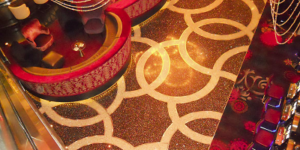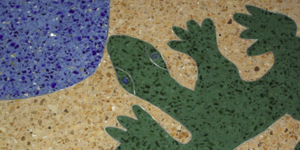 The next time you’re at an airport, hospital, convention center, school, large resort, government building or large office building, look down. More than likely what you’ll see underfoot is terrazzo.
The next time you’re at an airport, hospital, convention center, school, large resort, government building or large office building, look down. More than likely what you’ll see underfoot is terrazzo.
In indoor applications, terrazzo has a ground and polished surface that lends itself to creative design. The use of divider strips allows the material to be mixed in different colors and applied in a process similar to paint-by-number, so you can incorporate designs, logos, borders and just about anything.
 Terrazzo is not used much in outdoor applications, but, when it is, unpolished “rustic” terrazzo is common.
Terrazzo is not used much in outdoor applications, but, when it is, unpolished “rustic” terrazzo is common.
“Traditional” cementitious terrazzo has been used for centuries because of its durability and easy maintenance, but installing it is a labor-intensive and time-consuming process. Generally, traditional terrazzo is only used in large-scale applications.
 There are other limiting factors to using traditional terrazzo, as well. Its thickness — often as much as three inches — means other issues come into play. The substrate slab usually needs to be recessed. The thickness of the terrazzo increases the weight load. And it may be hard to find someone with the expertise to install traditional terrazzo properly.
There are other limiting factors to using traditional terrazzo, as well. Its thickness — often as much as three inches — means other issues come into play. The substrate slab usually needs to be recessed. The thickness of the terrazzo increases the weight load. And it may be hard to find someone with the expertise to install traditional terrazzo properly.
Epoxy terrazzo
In the 1960s, thinset epoxy terrazzo products came on the market. Their use began to take off in the ’70s as their many benefits became apparent.
“Epoxy terrazzo is excellent for multistory use, as it is relatively light and offers better flex strength than cement terrazzo,” says George Hardy, executive director of The National Terrazzo & Mosaic Association Inc. in Purcellville, Va.
 Robert Cain, president of Key Resin Co. in Batavia, Ohio, says these new products have many advantages over traditional terrazzo. “They are lighter weight, 3⁄8-inch versus 21⁄2 inches thick, high strength, high wear, … faster to install [and] can accommodate a wider variety of aggregates.”
Robert Cain, president of Key Resin Co. in Batavia, Ohio, says these new products have many advantages over traditional terrazzo. “They are lighter weight, 3⁄8-inch versus 21⁄2 inches thick, high strength, high wear, … faster to install [and] can accommodate a wider variety of aggregates.”
Epoxy terrazzo definitely offers more versatility in color and design. Unlike traditional terrazzo, epoxy is available in unlimited colors. Instead of just marble or granite chips, epoxy terrazzo aggregate options include glass, mother of pearl and synthetic chips. And, while zinc and brass divider strips are commonly used with traditional terrazzo, you also can use aluminum and plastic strips with epoxy terrazzo. So, let your creativity hang out — the sky is the limit!
 And there’s more good news. As Ken Korizon, manager of architectural sales at Polymerica Inc. in Carrollton, Ga., points out, the thickness of epoxy terrazzo is only 1⁄4- to 3⁄8-inch, but “because of the epoxy, its compressive strength is over 10,000 psi, compared to around 5,000 for cement terrazzo.”
And there’s more good news. As Ken Korizon, manager of architectural sales at Polymerica Inc. in Carrollton, Ga., points out, the thickness of epoxy terrazzo is only 1⁄4- to 3⁄8-inch, but “because of the epoxy, its compressive strength is over 10,000 psi, compared to around 5,000 for cement terrazzo.”
The thinner installation also means the concrete slab does not need to be recessed, which makes it easier for the concrete people and lowers the cost of pouring the slab. It weighs only around three pounds per square foot installed.
 And don’t worry about the fumes. Since the early days, epoxy technology has advanced so that “almost all epoxy terrazzo is installed with a 100 percent solid epoxy which has little or no odors or VOCs,” reports Korizon.
And don’t worry about the fumes. Since the early days, epoxy technology has advanced so that “almost all epoxy terrazzo is installed with a 100 percent solid epoxy which has little or no odors or VOCs,” reports Korizon.
Terrazzo troubleshooter Fritz Iselin, director of Niagara Research Consulting in Jacksonville, Fla., observes that more than 50 percent of today’s terrazzo market is epoxy terrazzo. “In the old days it was a matter of cost. Cement terrazzo used to be less expensive. Not so anymore.”
Not only is the cost very comparable, you can install epoxy terrazzo in larger sections. With traditional terrazzo you need to limit your sections to no more than about five square feet because of shrinkage, Iselin says. But with epoxy terrazzo, “there is no real shrinkage, so you can go as large as 15 to 20 feet.” You still need to honor control joints, however.
The installation process and tools required really aren’t much different for epoxy terrazzo than for traditional terrazzo. Both require mechanical polishing, and though usually done in the presence of water, in some cases dry grinding is possible. There is significant timesaving with epoxy terrazzo, however, because the epoxy cures overnight, rather than the three to seven days needed for traditional terrazzo.
 Another advantage to epoxy terrazzo is that it is stain resistant and non-breathable. “Because the epoxy resin is a non-breathable system, it does not sustain growth of mold or mildew, which makes it ideal for schools, hospitals and restaurants. Many pharmaceutical manufacturers use epoxy terrazzo in their labs and clean room environments,” Korizon says.
Another advantage to epoxy terrazzo is that it is stain resistant and non-breathable. “Because the epoxy resin is a non-breathable system, it does not sustain growth of mold or mildew, which makes it ideal for schools, hospitals and restaurants. Many pharmaceutical manufacturers use epoxy terrazzo in their labs and clean room environments,” Korizon says.
But that characteristic is also epoxy terrazzo’s Achilles heel. Cain explains, “Terrazzo overlays are beneficial just about everywhere because their advantages make them superior. The only limitation is that epoxy systems are non-breathing and subject to  problems associated with moisture transmission. … [though] there are now treatments and measures that can be used to allow their use in these situations.”
problems associated with moisture transmission. … [though] there are now treatments and measures that can be used to allow their use in these situations.”
Cementitious-based thinset terrazzos
If moisture is a problem but you need the advantages of a thinset terrazzo, you might consider polyacrylate terrazzo, which features a latex-fortified cement matrix veneer. This provides the strength for you to apply it 3⁄8-inch thick, Hardy says, but like traditional terrazzo, the color selection is limited and it requires a longer cure time than the epoxy systems.
 Gary Powell, construction renovation systems and terrazzo specialist with Mapei, in Deerfield Beach, Fla., describes a polymer and additive-enhanced cementitious-based terrazzo overlay product his company is introducing this summer as a hybrid material that falls between traditional and epoxy terrazzo. “It looks like traditional terrazzo, but has several of the benefits of epoxy — thin application, lighter weight and fast-curing … [and it] is more practical and economical than traditional terrazzo.”
Gary Powell, construction renovation systems and terrazzo specialist with Mapei, in Deerfield Beach, Fla., describes a polymer and additive-enhanced cementitious-based terrazzo overlay product his company is introducing this summer as a hybrid material that falls between traditional and epoxy terrazzo. “It looks like traditional terrazzo, but has several of the benefits of epoxy — thin application, lighter weight and fast-curing … [and it] is more practical and economical than traditional terrazzo.”
The installation procedure differs a bit from traditional and epoxy terrazzo, too, Powell says. After the divider strips are laid, the binder is screed raked into place. Then the aggregate is hand (or machine) broadcast and rolled with special equipment to settle the aggregate into the binder. Powell reports that within two to three hours you can walk on the terrazzo. Dry grinding can begin in 24 hours.
 Terrazzo is forever
Terrazzo is forever
For all intents and purposes, terrazzo is considered permanent. Higher up-front costs are offset through its long life. Terrazzo takes high traffic in stride. Maintenance is simple: daily sweeping and a neutral cleaner are usually sufficient.
The need to seal terrazzo depends on the binder matrix and the aggregate used. A terrazzo sealer might be needed in certain situations, such as a hospital, restaurant or clean room, if the terrazzo binder is cement-based and if the aggregate is porous (such as marble). How often you should strip and reseal depends on the traffic load. Use of other topical finishes depends on how much sheen you desire.
Terrazzo can be repaired, though matching may not be easy. It’s best to replace a whole section between divider strips if a repair is required.
 As demand grows, craftsmen are needed
As demand grows, craftsmen are needed
The industry is seeing a growing awareness of the benefits of terrazzo, and contractors are scrambling to keep up with demand.
“The thing I hear from first-time installers is that it is not as easy as it looks or sounds,” reports Hardy.
Iselin agrees. “Not many young men are coming into the business — it’s hard work. What we’re finding is that immigrants who have experience with the crafts in Europe and other places are coming here and taking up the trade.” Workmanship is a real big issue, he says. “[Terrazzo] is a piece of art — it is working art.” You need a certain skill level to achieve it.
Terrazzos — traditional, thinset  and otherwise — are special types of installations. Cain cautions individuals interested in learning the skills needed that “the learning curve for most new contractors has tended to be very steep. It is highly recommended to get thoroughly trained or hire experienced people to get started.”
and otherwise — are special types of installations. Cain cautions individuals interested in learning the skills needed that “the learning curve for most new contractors has tended to be very steep. It is highly recommended to get thoroughly trained or hire experienced people to get started.”
And don’t forget you need the right tools. Korizon points out, “An investment in the right machinery is necessary. This includes grinders for the floor, both heavy ones and flexible-shaft ones, and different types of mixers.”
While learning the craftsmanship of terrazzo installation, it’s good to visit projects where terrazzo is being installed, learn from a professional terrazzo mechanic, listen to your material manufacturers and suppliers, and then start small. As your talents and projects grow, so will your art.
For more information about terrazzo, visit The National Terrazzo & Mosaic Association’s Web site.













